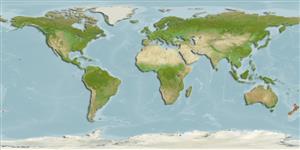>
Blenniiformes (Blennies) >
Tripterygiidae (Triplefin blennies) > Tripterygiinae
Etymology: Ruanoho: A vernacular name in maori, New Zealand.
Environment: milieu / climate zone / depth range / distribution range
Ecología
marino demersal; rango de profundidad 0 - 6 m (Ref. 84086). Temperate
Southwest Pacific: around mainland New Zealand.
Tamaño / Peso / Age
Maturity: Lm ? range ? - ? cm
Max length : 12.0 cm TL macho / no sexado; (Ref. 84086)
Short description
Morfología | Morfometría
Espinas dorsales (total): 20 - 23; Radios blandos dorsales (total): 14-16; Espinas anales 2; Radios blandos anales: 24 - 27. Males uniform grey to black with red fins and a bluish white margin to the anal fin during the breeding season. Females mottled greenish grey with an indistinct broken dark band along the base of the dorsal fins. Distinguished from other triplefins by the flattened pointed head and snout, the short, square caudal peduncle, and by having three spines in the first dorsal fin and 14-16 spines in the second.
Adults are commonly found in sheltered areas shallower than 5 m. Typical in shallow habitats in coastal mainland areas and seldom on offshore islands. Mainly found under rocks. They feed on a range of benthic invertebrates including ophiuroids, archaeogastropods, trichoptera and errant polychaetes (Ref. 84084). Eggs are hemispherical and covered with numerous sticky threads that anchor them in the algae on the nesting sites (Ref. 240). Larvae are planktonic which occur primarily in shallow, nearshore waters (Ref. 94114). They are caught by slurp guns and handnets (Ref. 84086).
Life cycle and mating behavior
Madurez | Reproducción | Puesta | Huevos | Fecundidad | Larva
Fricke, R., 1994. Tripterygiid fishes of Australia, New Zealand and the southwest Pacific Ocean (Teleostei). Theses Zool. 24:1-585. (Ref. 13227)
IUCN Red List Status (Ref. 130435)
Threat to humans
Harmless
Human uses
Pesquerías: sin interés
Más información
ReferenciasAcuiculturaPerfil de acuiculturaRazasGenéticaElectrophoresesheritabilidadEnfermedadesProcesamientoNutrientsMass conversion
ColaboradoresImágenesStamps, Coins Misc.SonidosCiguateraVelocidadTipo de nataciónSuperficie branquialOtolitosCerebrosVisión
Herramientas
Special reports
Download XML
Fuentes de Internet
Estimates based on models
Preferred temperature (Ref.
123201): 10.6 - 21.2, mean 15.9 °C (based on 162 cells).
Phylogenetic diversity index (Ref.
82804): PD
50 = 0.7500 [Uniqueness, from 0.5 = low to 2.0 = high].
Bayesian length-weight: a=0.00631 (0.00338 - 0.01176), b=3.09 (2.92 - 3.26), in cm total length, based on LWR estimates for this species & (Sub)family-body (Ref.
93245).
Nivel trófico (Ref.
69278): 3.3 ±0.4 se; based on size and trophs of closest relatives
Resiliencia (Ref.
120179): Alto, población duplicada en un tiempo mínimo inferior a 15 meses (Preliminary K or Fecundity.).
Fishing Vulnerability (Ref.
59153): Low vulnerability (10 of 100).
